Sorry, this entry is only available in European Spanish.
Yearly Archives: 2016
Solar Energy Wherever You Are
Many times the purpose of incorporating solar energy to our professional skills, scope of business or personal life has hovered in our head.
We have almost always run into the same barrier: time.
We are working or studying and we find it very difficult to have even a few hours a week.
It is rare to find training offerings that are not too short (few hours workshops) or too long (one or more years) and which in turn have an affordable price.
If we add the difficulty of having to move, because most are taught in presence way, finally we ended up postponing again and again this purpose.
In 2014 Sopelia gave, in collaboration with the Technology National University of Mar del Plata (Argentina), the Technical – Commercial Solar Energy Course in tele-learning (distance + presence) methodology.
In 2016 Sopelia updated and divided that training action in 2 specific courses:
* Technical – Commercial Solar Thermal Energy
* Technical – Commercial Photovoltaic Solar Energy
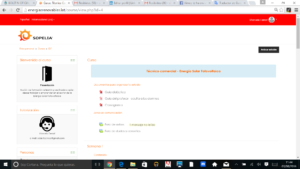
Sopelia rode them on a Moodle 3.1 platform and the result is 2 courses in e-learning methodology.
This means you can receive Solar Energy training with the best market value wherever you are.
You only need a computer, smartphone or mobile device and Internet.
Being the 1st edition there is a 50% off list price.
These two courses provide technical and commercial training in solar energy domestic applications with the aim of spreading the technology and develop human resources for incorporation into work and business world.
You will identify the most relevant aspects of solar energy within the current energy landscape.
You will define, describe and analyze the most important features of solar energy.
You will know the composition, understand the operation, design and maintenance of facilities to implement thermal and photovoltaic solar energy projects.
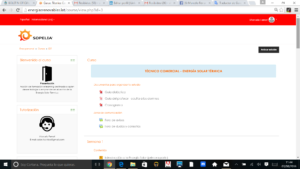
It is a training aimed at students and technical careers graduates, technical schools graduates, engineers, architects, professionals and installers of related sectors (air conditioning, electricity, rural), people with experience in renewable energies, environmental professionals and individuals interested in incorporating solar energy into their lives.
The 2016 edition starts on September 19th and ends on November 25th.
You can register until 16 September inclusive in www.energiasrenovables.lat
If you are under 30 years old and live in Latin America, with the course completed, you can apply to be Sopelia Country Manager in your country of residence.
And if you are under 25 and live in Latin America, you can get a 50% scholarship and finished the course, apply to become Sopelia Trainee.
If you speak Spanish you have no excuses, Solar Energy wherever you are with Sopelia.
Passive Solar Energy
One of the most important issues in energy conservation areas and solar energy use is undoubtedly homes and workplaces air conditioning application.
This sector accounts about 40% of the total energy consumed. The savings can be achieved by using solar energy for heating is of the order of 60% to 80% depending on house design.
The principles of bioclimatic architecture should be applied in all new urban plans.
When speaking of passive solar architecture, we talk about modeling, selection and use of passive solar technology, which is capable of maintaining a comfortable and pleasant temperature home environment through the sun. This type of architecture is only a small part of the energy efficient buildings design and is considered as part of sustainable design.

There are three types of solar gain:
1) Direct solar gain: refers to the use of windows, skylights and blinds to control the amount of solar radiation reaching the inside of a housing, in combination with mass floors.
2) Indirect solar gain: is achieved through the skin of the building, designed with certain thermal mass. An example of this gain is also the garden roof.
3) Isolated solar gain: is the process in which the main thing is the sun heat passive capture, and then transport it inside or outside the home.
There are considerations to take into account in this type of architecture implementation, to give his best result:
* Building orientation
* Construction features
* Environment use

In existing buildings we can always intervene to improve thermal insulation, sun blinds open in winter or adding a glass gallery on the north side of the house if we are located in the southern hemisphere.
To heat the house with the sun, a clear winter north facade without many neighbors who clog the midday sun is needed.
Main glazings must be on the north facade. For example, if we are located in the southern half of Argentina we need 1.4 to 2 m2 of north glass for every 10 m2 stay we want to heat.
Windows should be closed with curtains or blinds at night to heat captured not escape. It is good to improve thermal insulation as far as possible and have thermal mass (building material in walls, floors) which accumulate the heat of the day to the night. For summer it is necessary to place eaves, awnings, vines, etc. that shade windows in.
You can acces more Spanish language content like this in Manual Técnico – Comercial de Energía Solar Térmica by Sopelia.
PV Profitability
The profitability of a photovoltaic system must be analyzed with certain nuances.
The weightiest factor when deciding whether it is feasible or not, is the potential energy savings during their years of life.
In the case of an isolated photovoltaic system, economic factor is not the main determining factor in deciding whether or not installation (electrification of rural areas, marine signaling, energy demand in remote locations, etc.).

Isolated (Off-grid) Systems
Installation can be evaluated for 2 reasons:
1. A range of total supply needed
2. Power grid not reach where energy demand originates
In the latter case you can opt for laying a new distribution line from the nearest point of the overall grid or choose an autonomous system.
When great powers are not needed and consumption is moderate, the option of autonomous generator is more interesting. Obviously, the higher or lower placement solar radiation level is another determinative factor.
In abundant wind areas, a wind turbine or a wind combined with photovoltaic system may be the most convenient option.
In cases where is needed a fairly large power requiring a large number of solar modules while consumption was not high enough to justify the laying of a grid line, the diesel generator can be the best option.
If both budgets (solar isolated and line grid laying) are of similar magnitude (or even laying a grid line is slightly higher), it can be more interesting access to the electricity grid, which will ensure any consumer at any time of year.
Grid connected (On-grid) Systems
It consists of a module field and inverter which can convert DC generated into AC identical to that of the electricity distribution network, to inject energy produced by the modules into the grid.

In return, you can received a contribution (feed-in tariff) established by law for a period which generally ranges between 15 and 25 years.
To realize the economic study should first determine electricity production depending on the sunshine hours of installation location and installed peak power.
Annual electricity production is then multiplied by the contribution is allocated to the project.
Finally a cash flow is prepared detailing revenues (sale of electricity and taxes recovery) and expenses (initial investment, annual maintenance and insurance costs, administrative and financial annual expenses) for the entire period.
From the data obtained the recovery period and IRR of the investment is determined.

The other way is the net-metering.
In this case, the owner of the photovoltaic system can take power from the grid when their system can not provide enough to meet demand, and inject energy to the grid when their system produces above necessary to meet demand.
The solar module prices fell reaching the threshold of U$D 0.50/W Exworks for conventional crystalline silicon modules.
Simultaneously, the price of electricity generated from fossil fuels is increasing annually.
In fact, it is estimated that several European countries will reach grid-parity (equal price between PV and conventional electricity) in 2020.
In developing countries, photovoltaic systems connected to the grid will remain still an expensive option because of the high subsidies electricity generation and distribution receive; limiting their development.
The turnkey price of a fixed installation connected to the grid (modules, support structures, inverters, protections, measurement systems, project costs, installation and administrative permissions) ranges from U$D 2 and 5/W depending on the facility size and location.
You can access content like this in Spanish in the Manual Técnico – Comercial de Energía Solar Fotovoltaica de Sopelia.
Solar Ecuador
There is a saying “for sample we need only a button”.
If you visit the Ministry of Electricity and Renewable Energy of Ecuador website you will see a section called “Flagship Projects”.
Lets make a bet. Of a total of 9 renewable projects, how many you think are of solar energy?
Given that we are talking about a country with one of the highest levels of solar radiation probably our response would be 1 or more.
The correct answer is zero.
Of the 9 total projects, 8 are hydroelectric and 1 is wind.
We can conclude that there is a strong rainfall dependence and a lack of renewable energy matrix diversification in Ecuador.

Being located in the middle of the planet, the potential use of solar energy in the country is huge and its extensive use would help achieve energy independence in the long run.
Leaving aside the dominance of hydropower, Ecuador has made progress in wind generation in various regions.
In Loja, the Villonaco Windfarm, located 2,720 m above sea level, has 11 turbines that generate 16.5 MW.
Renewable energies have been consolidated in Galapagos, with advanced projects in wind, photovoltaics and biofuels energy.
In 2007, three wind turbines were installed on San Cristobal island, to give it 2.4 MW. This wind park can cover 30% of island electricity demand.
Since 2005 operates a photovoltaic park in Floreana, which covers 30% of the electrical energy required.
There is a wind park in Baltra with 2.1 MW capacity.
In solar energy, low activity remained thanks to agreements with German government.
Since 2004, the German Energy Agency launched the Solar Roofs Program to promote renewable energy pilot projects in regions of high solar radiation.
The Government developed photovoltaic projects in 8 Gulf of Guayaquil municipalities. The Eurosolar Program gives electricity to 91 isolated communities with support from the European Union.

For solar energy development a law that favored investors was created, but it didn´t work because there´s no financial guarantee for such investments.
The current renewable energies regulation in Ecuador is still quite poor.
It is difficult to develop big projects in the country, so that distributed generation using photovoltaic systems connected to the electricity grid should be promoted.
But it happens that there is no regulation for these systems which discharge energy to the national grid, no values to remunerate people who bring energy are set and, on the contrary, the excess energy being poured it is also charged.
Wind resource is scarce in the tropical region where the country is located as there are no significant winds and in the evening these winds are practically nonexistent.
Ecuador should take advantage of geothermal energy taking into account the geological conditions of the country, but develop this energy involves making very expensive studies.
Ecuador’s location is optimal for solar energy harnessing.
There is another saying “God gives bread to those who have no teeth.”
Solar business and projects in Latam with Sopelia
The Solar Energy Generates Employment
IRENA 2016 annual report figures on employment and renewable energy reveal that the worldwide number of people employed in the renewable energy industry increased by 5% in 2015, reaching 8.1 million.
There was a slight decline compared to previous years, but the number of jobs in this sector continues to increase in the long-term projections.
The most important contractors in this sector are mainly related to solar energy, which accounted for 2.8 million jobs in the same year (increase of 11% compared to 2014).
Countries with the highest employment figures in renewable energy sector were China, Brazil and the United States.
In Brazil, current estimates indicate that for each photovoltaic MW installed, there are directly or indirectly 20 to 30 jobs create.
In this country it is expected that solar photovoltaic energy will be the industry with the fastest expansion due to facilities and plants planned, which are expected to reach 3.3 GW of solar energy generating by 2018.
They could create 60,000 to 90,000 jobs by comparison with what happened in Germany: 100,000 solar jobs were counted when this sector reached 7 GW in 2012.
Solar energy has great potential to generate long term employment in Brazil and Latam.
The reduction in solar related costs has helped the installation of small and large scale solar photovoltaic plants increase.
The solar photovoltaic energy plants increased by 20% in 2015 with China, Japan and the United States in the lead.
China is the largest employer with 1.7 million jobs in 2015.
As the photovoltaic solar industry is becoming increasingly decentralized, different parts of the value chain (such as assembly, distribution or after-sales service) are easy to relocate, thus creating more jobs.
The labor market and the planned expansion of solar photovoltaic energy will be one of the main topics to be discussed at the Job & Career Forum at Intersolar South America.

This event not only provides a platform for job seekers and other solar professionals to obtain more and better information on current labor trends, but also solar companies and human resources specialists will be present to promote their own job deals. This platform is being organized with the support of Sopelia.
Referring to the following code 16104DD609D43B you will get a 10% discount on your ticket to Intersolar South America by accessing the following link.
With events in 4 continents (Munich, San Francisco, Mumbai, São Paulo, and from 2016 in Dubai), Intersolar is the largest trade fair in the world for the solar industry.
Intersolar South America will take place at the Expo Center Norte in São Paulo, Brazil.
The fair and the congress will focus on the areas of photovoltaics, PV production technologies, energy storage systems and solar thermal energy technologies.
Politicians and leaders with ideas lacking, you can say higher but not clearer: solar energy creates jobs! And it is a huge boost for any country economy.
Students, professionals and entrepreneurs: solar energy is a sector with great potential where we can develop professional or corporately and at the same time contribute to improving our environment.

If you want to train you (and in some cases access to job opportunities) from wherever you are, you just have to wait until next September (enrollment period begins in August) to access the best e-learning training of market with Sopelia.
And do not forget to visit Intersolar South America before.
Cuba Solar Pv
Since Soviet Union demise and US blockade intensification, Cuba has made great efforts to get its energy supply.
Its plans included solar energy, mainly in inaccessible areas where the national electricity system (medical clinics, rural hospitals, social clubs, TV rooms and schools) fails.
In medical clinics 400 W power equipments were installed to provide energy to 1 fridge 12 lamps of 15 W, 1 television and 1 radio to communicate with other clinics and hospitals.
In schools solar equipment was installed to provide lighting systems, TVs and computers.
The government built TV rooms, that were equipped with solar systems, in villages that have no electricity. Each TV room has 1 solar module, 1 TV, 1 video and 30 or 50 seats according to population density. The investment was around U$D 4.500 per TV room.
The first large-scale photovoltaic energy facility has installed more than 14.100 modules domestically manufactured. The plant is located in Cienfuegos province. The park, which was build in 2012, connected 2.6 MW to the national grid.

There are also installed photovoltaic plants connected to the grid in Guantanamo, Santiago de Cuba and Santa Clara provinces. The last one can produce electric energy to daily supply about 750 homes at full capacity and can contribute to the national grid with about 962 kW.
The photovoltaic solar park of Pinar del Rio has connected its first MW of the 3 provided, to the national electricity system. This facility, located in the area of Cayo Cana, provide energy to some Wells that supply water to provincial capital and 8,000 people.
Today are already active over 15 photovoltaic plants, in which each MW installed, on average, can produce 1,5 GW/h per year; saving the country annually 430 tons of fuel.
This leap to large-scale plants shows government interest to increase solar energy use and the opportunity to exploit an abundant resource, since the solar radiation average in Cuba is greater than 1,800 kW/h /m2 per year.
In addition, modules are manufactured in a factory located in Pinar del Río province. The local industry has substantial production line technological improvements, which in 2015 reached 60,000 modules focusing on 250 W panels.

Another sign of solar energy interest is the dean Solar Energy Chair, which founded on September 6 2001, at the University of Havana, reaffirms the renewable energy use momentum in Cuba where photovoltaics plays an important role.
Solar business in Latam with Sopelia
What is the best solar collector?
What qualities should we consider when selecting a solar thermal collector?
Are two:
1- Its constructive qualities. Determines the durability and architectural integration possibility.
2- His energetic qualities. Determines economic performance.
In some respects both qualities are interrelated.
A good solar collector is one who possesses both qualities well balanced for the intended application.

There is no use a solar collector with an extraordinary energy intake if their constructive qualities fail or degrade quickly, since the profitability of these facilities is measured in the medium term.
There is no use a solar collector with extraordinary constructive qualities if their energetic qualities fail, because, simply, it is not fulfilling its main task.
By observing the solar collector performance curve, we see that it depends on a variable which is the temperature T, which in turn depends on the solar radiation I, on solar collector fluid inlet temperature Te and on ambient temperature Ta.
That is, the performance of a collector depends:
– On one side of the weather conditions, given by I and Ta,
– On the other side of the working conditions, that is, of what it is used, given by Te.
Therefore, when selecting a collector must be considered:
1) The application will have (only ACS, only heating, hot water and heating, pool heating, etc.).
2) Climatic and radiation conditions of facility location.
3) Models performance curves.
4) Equipment price.
5) The economic profitability (based purely on the relationship between price and yield) and investment recovery period.
6) Its construction quality.
You need to balance construction quality with energetic quality.

There is an open debate among professionals about which of the two most used collectors technologies is the most appropriate: flat or vacuum tube collector?
Those who opt for vacuum tube collectors consider them more advanced and argue that in the future this technology will eventually displace definitely flat plate collectors because of their better performance.
The increased cost gap of vacuum tube collectors respect to flat collectors has been reduced and we can find collectors of both technologies at the same price.
Supporters of the vacuum tube collectors consider opting for them is compensated, because by offering higher performance per m2 we will need to purchase less collectors.
This is not necessarily true, especially in small facilities:
In a small facility that only provides ACS with good weather and radiation conditions, flat plate collectors performance and profitability will be greater.
As you increase the size of the installation, the vacuum tube collector highest performance will offset the lower absorbing surface.
We will also consider building integration of vacuum tubes direct flow collectors (U-Pipe) that can be placed vertically covering a façade or balcony.

In short, a properly trained professional must assess based on the following factors choosing one or the other technology:
• Specific requirements of the installation
• Location climatology in every season
• Previous experience
• Budget availability.
You can find content like this in the Technical – Commercial Solar Thermal Energy Manual by Sopelia
Cuba Solar Thermal
The Cuban population spends between 529 and 791 GWh/year (6% of electricity) to heat water.
Considering the housing technical conditions and water service stability, 1 million Cuban families could receive hot water service using solar energy.
The first ad written in Spanish about commercial solar thermal technology, published in a mass medium communication was held in a Cuban newspaper in the 1930s.
The equipments introduced at that time were mainly from US and its high costs made them only available to economically advantaged clases of the country.
In 1978 a polygon was established to evaluate solar heating systems and the Cuban Standard for systems installation was approved in 1987.
In that period, first models adapted to island climatic conditions was developed and Cuban patent for a solar thermal compact system was obtained in 1979.
Between 1982 and 1991 they were built and installed over 13.000 solar thermal water heating systems in kindergartens and other social institutions. Most of these systems are now out of service because maintenance and technological problems.

From 1992 to 2006 about 4.000 flat collectors and compact equipments, several imported, were installed and were performed efforts to manufacture in the country.
In 2007 Chinese vacuum tube equipments were acquired for pilot test performing purpose.
Approximately 85% of the installed capacity corresponds to the tourist hotel sector.
Solar thermal systems for applications such as drying of agricultural and industrial products are also used.

The solar energy research centers carry over 2 decades working on solar drying technologies development models for timber, medicinal plants, grains, seeds and other products that now allow industrial use of these cameras and provides great economic benefit.
Very advanced solar dryers for tobacco drying and curing technologies developing have also succeeded.
The mentioned centers also work in the use of solar energy in controlled climate chambers for vegetables production and high quality seeds, refrigeration and cooling. The research focuses on potatoes, tomatoes and other products production that currently Cuba is forced to import.
Solar business in Cuba and Latam with Sopelia
Solar Creativity
When Federico Redin answered the phone call at his office in Bahia Blanca (Argentina) he was happy because it was to request their installation services in a new solar energy project.
But when he came to the house where the project would be located, he realized that the facility had some complexity.
It was a continuous use indoor pool with bathroom, dressing room and kitchen.
The pool was closed with rustic solid brick walls, aluminum DVH low quality openings in the enclosure and transparent polycarbonate roof. A challenge.
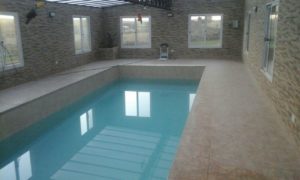
After the visit, which solution adopt to optimally configure the installation was going around in his head.
Appealing to the characteristic creativity of Argentine people, Federico took an unconventional solution: swimming pool conditioning by floor heating (in the transit zones of the enclosure and in the pool itself).
In this way it would achieve heat the pool regardless of the type of water containing the glass and more efficiently, since conventional pool heating has the negative inertia of moving water.
By heating the pool water with a conventional boiler the water is set into motion with the same pool pump, causing cooling it by this movement; which decreases the overall installation performance.
Therefore, a more powerful source of energy and more thermal reaction is needed.
We know that using solar energy do not have a large thermal reaction, ie the heating time is slower.
By heating the pool with underfloor heating water turns hot through the concrete, once in regime, it has more thermal inertia and allows solar energy to maintain that regime.
The radiant “glass” pool and the transit floor area of the enclosure receive input from a conventional gas boiler, which is responsible for putting installation in system, and 7 heat pipe collectors supplying directly fluid to the circuit (without heat exchanger) that transfers heat in sunshine.
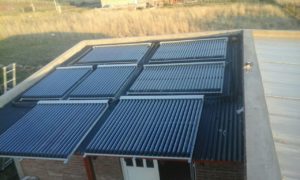
Temperature is regulated with a mixing thermostatic valve to not degrade the soil at high temperatures.
The system has a thermostat for transit zones and a thermostat for swimming pool water.
Then room or water temperature are discriminated with electric heads located at the underfloor heating collector, separating pool and transit zones of the enclosure.
The pool has a natural salt chlorination system (salt water 5%) thus avoiding the use of chlorine.
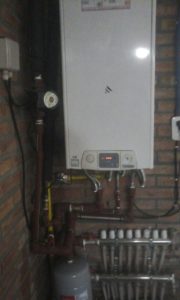
Having 2 separate circuits (the pool and underfloor heating), we protect the boiler to heat salt water, which quickly will cause severe and irreversible damage to it.
Federico Redin is Sopelia facilities expert advisor.
